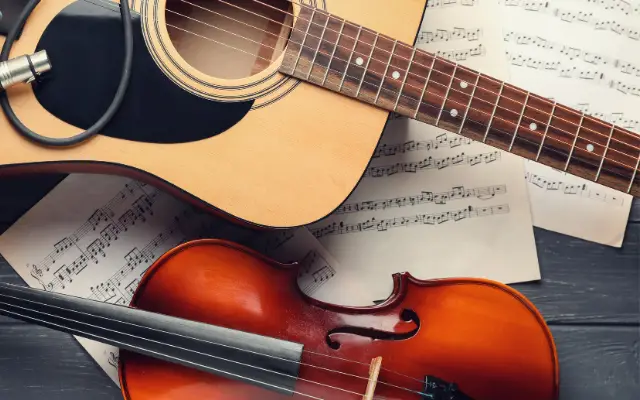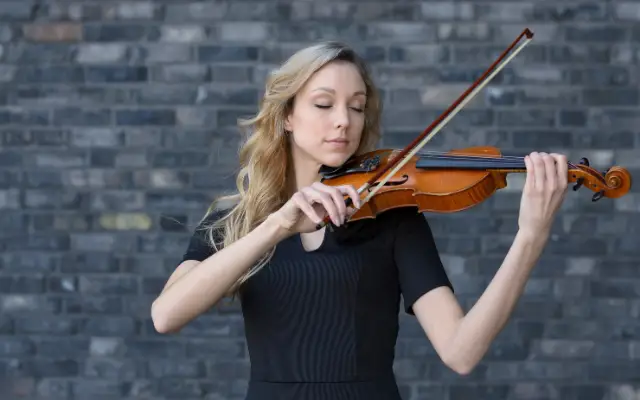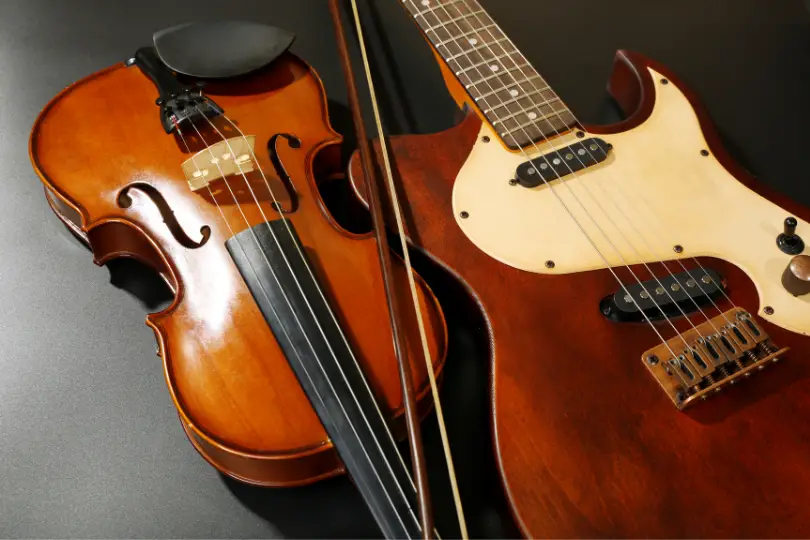If you already know how to play the guitar, you might be wondering if the violin should be your next pick. Many people think that they can get a better start on the violin if they already know a thing or two about another stringed instrument like the guitar.
The violin is considerably harder than the guitar. The violin posture is much less natural than the guitar. Also, the violin is a fretless instrument, so getting fingerings right and achieving good intonation (note pitch) is much more challenging. Bowing is also a lot harder than plucking.
That being said, knowing how to play the guitar makes things easier in a way because you don’t have to relearn music theory all over again when you pick up the violin.
Table of Contents
Learning the notes on the violin for a guitar player

When you look down at the guitar’s fretboard, you can easily identify your finger positioning and the note that will ring out.
It is not the same with the violin, as you need to know exactly where to place your fingers based solely on muscle memory or by looking.
Learning the notes on the violin is one of the biggest challenges for guitar players. Without frets to guide them, the initial learning curve is often quite steep.
On top of that, the fretboard on a guitar is considerably longer than on a violin, which dramatically reduces the margin for error.
If you place one finger wrong on the violin fretboard, you will end up playing a different note altogether. That’s also what makes the violin such an expressive instrument.
Owing to its fretless fingerboard and the technique required to produce sounds, the violin demands a considerable amount of concentration from the player.
Most violin players cannot sing while playing the instrument, as playing demands the full attention of the player.
You also have to adjust your sight in order to see your fingers at a relatively horizontal angle on the violin’s fingerboard – a stark difference from the more top-down perspective when playing the guitar.
Violins do not have any markings on the sides of the fingerboard either, so your fingers must be guided based on memory and sight alone to play the right notes.
Violin posture for a guitar player

The posture of the player is also considerably different when picking up a violin as compared to the guitar.
To play for a longer period of time and to learn the different techniques, you also need to have a correct violin posture. It is much more important than most people think.
The posture you choose when playing the violin will affect the bow hold, the intonation, stroke, and the tone of the instrument.
All violin techniques are based around the proper violin posture. If you do not maintain the right posture, your progress as a violinist will suffer.
Ideally, you will need a dedicated violin instructor to guide you about the right posture. However, here are a few pointers to follow when holding the violin:
- You can either stand up or play sitting. In the beginning, it’s best to sit and position your feet to touch the heels together, forming a “V.”
- Lift your right foot and move it a bit back. The left foot will help in guiding the violin’s angle.
- Turn your head left until your nose aligns with your left foot. Drop your chin slightly and place it on the chinrest.
- The angle of the violin must line up with your left foot.
- Avoid bending the spine and just let your body relax. You must learn how to steady the violin using only your chin.
- Curve your hand gently around the fingerboard and line up your elbow with the violin and your left foot.
- Then, you must lift your right arm and drop your wrist to let your fingers relax in a gentle, slightly curved position. You will hold the bow this way.
As you can see from the above, the violin posture is a lot more complex and less natural than the guitar.
The guitar posture generally requires simply placing the instrument on your leg in a (more or less) horizontal position while sitting, holding the neck with your left hand.
Bowing for a guitar player

Another key difference between the guitar and the violin lies in learning how to use the bow.
The violin bow, or the fiddlestick, is a tensioned stick that has hair covered in rosin. It is usually made from horse tail hair and is moved gently across the violin’s strings to produce sounds.
Whereas guitar players can use a pick, or choose to play with their fingers, violinists mostly play with the bow (except pizzicato).
Bowing requires extreme concentration and high coordination between your left and right hand. The movement of the bow must be timed precisely to the positioning of your fingers depending on the kind of sound you want to produce.
Learning the various bowing techniques is also an uphill challenge. You will have to learn both down-bows and up-bows, along with techniques like the staccato, the legato, and the spiccato.
To top it off, violins virtually have zero sustain, and moving around the smaller neck with a bow that’s around the same length as the violin (or longer) is quite difficult.
It’s often discouraging for guitar players when they are not able to get a good sound from the violin from the get-go. On average, it can take a few months for a guitar player to produce a decent sound on the violin.
The violin is also inherently loud, so playing it loudly, especially when you can’t play well, can be difficult for the people around you.
Finger patterns for a guitar Player
The standard finger patterns for the violin are taken from the major scales. There are other finger patterns such as the contractions and extensions, and these are often taken from the minor scales or other combinations.
There are four basic violin finger patterns:
- 1-23-4 (Major Finger Pattern)
- 12-3-4 (Minor Finger Pattern)
- 1-2-3-4 (The Whole Tone Finger Pattern)
- 1-2-34 (The Whole Tone Finger Pattern)
The problem most guitar players face is discerning where exactly to keep their fingers. Guitar players are used to guiding their fingers based on the frets and the dots on the top of the guitar fretboard.
Without any such guidance on the violin’s fingerboard, it requires a considerable amount of practice before a guitar player is able to position their fingers on the right notes.
On the other hand, knowing the guitar will generally make it easier and more comfortable for you to press and hold violin strings.
Again, while you can learn the violin on your own, getting a teacher will make things considerably easier and more efficient.
Getting a basic violin sound for a guitar player
The violin plays very differently to the guitar, so getting a basic violin is not as simple or as straightforward.
On a guitar, you simply have to hold down a string on a fret and pluck the string. The position of the note is clearly defined, and the note can ring clearly with little effort.
On a violin, you have to learn how the notes sound by ear and then remember their exact positions on the fingerboard.
To get a basic sound, you also need to use the bow correctly. It must run along the string, and you need to produce a finger vibrato to sustain the sound.
Because it’s so difficult for a guitar player, or any new violin player, to get a basic sound from their instrument, many get discouraged and quit after a few weeks.
The learning curve for the violin is very steep in the initial few months. As a result, you have to stick with it for at least a few months to see any real results.
Vibrato and advanced techniques for a guitar Player
As a guitar player, before you can move on to vibratos and other advanced techniques on the violin, you need good intonation and a decent understanding of the first and third positions.
If you want to produce a vibrato on the violin, you will need lots of practice. In the beginning, the sound might resemble sandpaper rubbing against a nylon surface – or even a barfing cow!
It’s a broad movement that requires coordinating the vibrato from your left hand with the bow movements on the right.
Unlike the guitar, many instructors recommend mastering the technique without the bow first. Once you have the finger movement down, you can then add in the bow.
Many guitar players tend to collapse their fingers on the violin during the vibrato, which affects the sound. Again, it’s a smaller fingerboard compared to the guitar, so you need to spend time learning to position your fingers.
Vibrato techniques
There are three major vibrato techniques: the finger vibrato, the arm vibrato, and the wrist vibrato. With time, you will learn how to combine and use both.
The finger vibrato is deeper, though a bit slower, whereas the arm vibrato is much broader, though slower. These concepts are completely new to a guitar player.
These techniques aren’t just focused on the movement of your left hand. Advanced bowing techniques, like the detaché bowing technique, require considerable practice. In this technique, each stroke of the bow must not connect to another note.
There’s also the Tenuto, which requires holding out the note to its full value.

